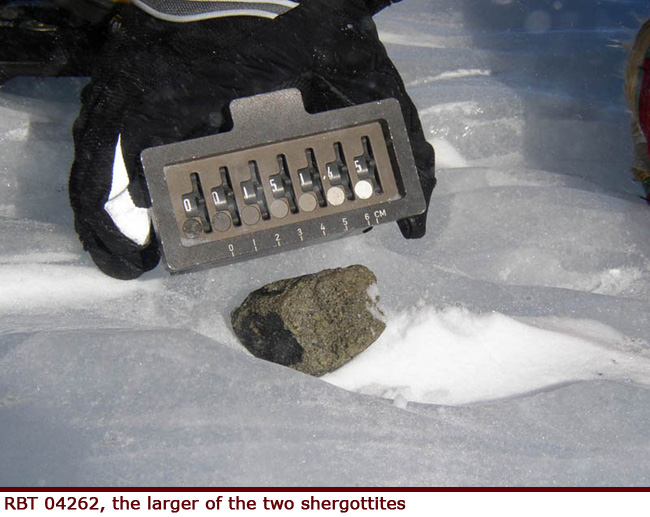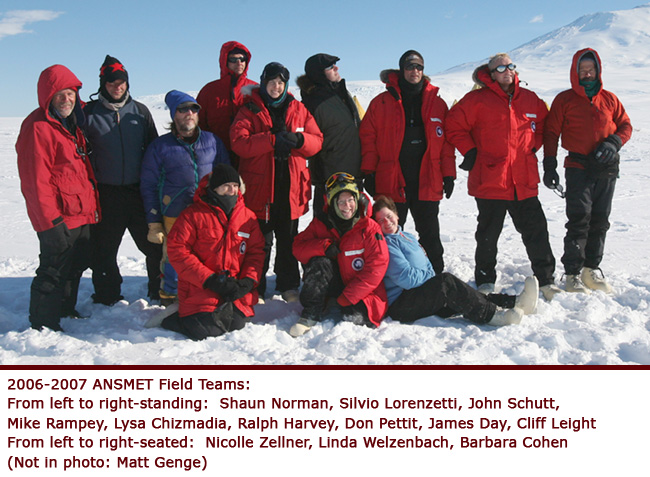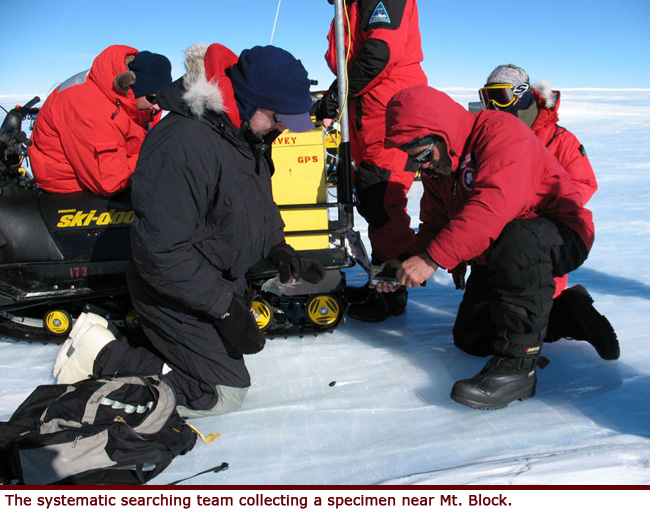
This newsletter reports 357 new meteorites from the 2004 and 2005 ANSMET seasons from the LaPaz Ice Field, Larkman Nunatak, Miller Range, MacKay Glacier, Mount Pratt, and Roberts Massif. These new samples include two olivine-phyric shergottites (paired), two low FeO ungrouped chondrites (paired), a ureilite, four howardites (2 pairing groups), a brecciated eucrite, a mesosiderite, L and H impact melts, a type 3 L chondrite, 3 CM2 chondrites, and a CO3 chondrite.
The low FeO chondrites have high metal contents (similar to H chondrites), but FeO contents lower than H, L and LL. These characteristics are shared by Burnwell and this new meteorite may have some affinities with it. The PRA howardites contain an unusually high number of carbonaceous chondrite (CM) clasts, illustrating that meteoritic breccias are mixtures of different impactor and target rock types in the regolith.
The olivine-phyric shergottites are characterized by the presence of maskelynite, and have Fe/Mn compositions clearly within martian meteorite values. The presence of both olivine and pyroxene phenocrysts in these shergottites make them similar (perhaps) to several other shergottites such as DaG 476/489, NWA 1195, 2046 and 2626. Similarities and differences between these new samples and other shergottites await further detailed study by the martian meteorite community.

Finally, we would like to bring to your attention to LPSC sessions highlighting ANSMET samples. Talks and posters throughout the week will highlight the unusual achondrite RBT 04239, nakhlite MIL 03346, the new lunar meteorite MIL 05035, the unusual hornblende-bearing R chondrite LAP 04840, metal-rich chondrites QUE 94411 and MIL 05082, other Antarctic lunar and martian meteorites as well as many other unusual chondrites.
Fabulous Frozen FindsFabulous Frozen Finds is a new brief summary of new ANSMET meteorite finds that are being made available for
scientific research by the US Antarctic Meteorite Program. This publication is aimed at other scientific organizations that
are not necessarily part of the mainstream meteorite community. Fabulous Frozen Finds will be distributed twice yearly and
will be available at the following website: http://geology.cwru.edu/~harvey/fff/
Samples from all of the specimens highlighted in Fabulous Frozen Finds will, of course, be made freely available to qualified
researchers around the world.
In October 2006, Terrie Bevill left ARES to take a new position with the Orion Project. Terrie has been with ARES Curation since April 1997, and supported all of our collections by maintaining databases and webpages. In particular, she maintained the meteorite database that documents new meteorite samples, and the many changes made to them. She also worked with the MPL staff twice a year to produce beautiful newsletters announcing new meteorite samples. Terrie also provided an interface between the US Antarctic Meteorite collection and the Nomenclature Committee of the Meteoritical Society. Her expertise and tireless dedication to our collections will be missed greatly.
Additions to our webpagea) New Sample Request Form
The Meteorite Working Group has made some changes to the sample request form. Several fields have been added to the form to
make consideration of requests more efficient. First, we are asking PI's for a title for their research project. Second, any
collaborators on the project are named and institution identified. Third, if samples are requested for multiple analytical
techniques, the mass of sample required for each technique is now required. And finally, certification of a research advisor
who is a permanent faculty or research staff member at the institution is required. Omission of any of this information could
cause a delay in any given request and associated sample allocation.
b) Allocation guidelines and special list online
Because the US Antarctic Meteorite Collection is maturing and available sample mass diminishes, samples are added to our protected
(or special) list annually. In order to facilitate the flow of information, we have placed this list online on our webpage, along
with the allocation guidelines for meteorites. Please consult these before making a request to be certain you are making a request
that is consistent with the available sample material.
Currently there are too many thin sections that have been out for greater than 4 years. At the request of the Meteorite Working Group, we are recalling all thin sections in two categories: a) those that are on the special list, and have been in your possession for greater than 1 year, and b) those that have been in your possession for greater than 4 years. In addition, these samples will be photo-documented to update our database. We anticipate the latter will aid our ability to locate the best and appropriate sample for any given request. Any PI who does not send in recalled thin sections could face a delay in having new requests reviewed and therefore samples allocated. If samples are still being studied by a given PI, those samples must be re-requested. If the thin section recall applies to you, you will be receiving a letter and email in the near future, and we want to thank you in advance for your cooperation in keeping our collection well maintained and characterized.
Lunar Meteorite CompendiumA compendium of 42 lunar meteorites has been completed by the MPL staff. It will be placed online sometime this spring. Because there are new lunar meteorites being discovered annually, these will have to be periodically updated. If you know of research that is not mentioned or covered in the chapters, please let us know – they are intended to be comprehensive summaries of samples. We will update them as frequently as we can. Please send information to: kevin.righter-1@nasa.gov.
The most recent ANSMET field season is now in the books, and while it was a tough season physically, the results should please anyone who's a customer of the Antarctic meteorites program. We deployed two teams: an 8-person team to conduct systematic searching on icefields around the Mt. Block / Mauger Nunataks and Larkman Nunataks region, and a 4-person team to conduct reconnaissance of several widely spaced icefields in the Graves Nunataks region. Both teams faced a lot of nasty (but typical, and expected) weather; roughly 50% of the days were too windy to work effectively. In spite of this, a lot of specimens were recovered. The systematic search team brought back 680 specimens, most of them from the Larkman Nunataks icefields, where the team foot-searched a very productive moraine on days too windy for snowmobile searching. The reconnaissance team felt the effects of the weather more severely; not only did high winds hamper their searching efforts, but it also limited their ability to move from one site to another via Twin Otter. In spite of this, the reconnaissance team brought back 176 from 4 sites, bringing the overall total for the 2006 collection to 856. And the word on the street is that the proportion of finds that are unusual, either in terms of size or classification, is higher than we've seen lately. By late summer we should know if this is true, or just wishful thinking by our wind-blown team.
One programmatic note. Budget constraints at NASA mean that there will be no reconnaissance team for the 07-08 field season; furthermore, there are no clear prospects for support at any time in the future. The systematic search efforts funded by NSF are solid for at least two more seasons, so there's no fear that the supply of Antarctic meteorites will dry up. However, it's also clear that the past 5 years of reconnaissance team activity have been exceptionally valuable, bringing many important new meteorites to the community (as this edition of the newsletter demonstrates). Over the next year I'll be reading the tea leaves carefully, looking for signs that I should pursue renewed support for the reconnaissance team. If you feel strongly that the two-team efforts should continue, I urge you to let me know, and consider ways you might bolster our case for re-establishing funding in the future.

